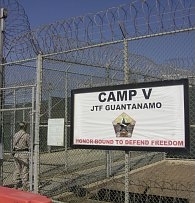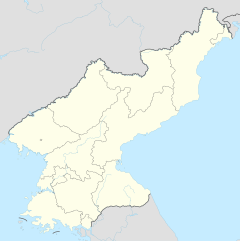
Internment is the imprisonment of people, commonly in large groups, without charges or intent to file charges. The term is especially used for the confinement "of enemy citizens in wartime or of terrorism suspects". Thus, while it can simply mean imprisonment, it tends to refer to preventive confinement rather than confinement after having been convicted of some crime. Use of these terms is subject to debate and political sensitivities. The word internment is also occasionally used to describe a neutral country's practice of detaining belligerent armed forces and equipment on its territory during times of war, under the Hague Convention of 1907.
Hoeryong concentration camp was a prison camp in North Korea that was reported to have been closed in 2012. The official name was KwallisoNo. 22. The camp was a maximum security area, completely isolated from the outside world.
The human rights record of North Korea is often considered to be the worst in the world and has been globally condemned, with the United Nations, the European Union and groups such as Human Rights Watch all critical of the country's record. Most international human rights organizations consider North Korea to have no contemporary parallel with respect to violations of liberty.
Yodok concentration camp was a kwalliso in North Korea. The official name was Kwan-li-so No. 15. The camp was used to segregate those seen as enemies of the state, punish them for political misdemeanors, and put them to hard labour. It was closed down in 2014.

The Guantanamo Bay detention camp is a United States military prison within Guantanamo Bay Naval Base, also referred to as Gitmo, on the coast of Guantánamo Bay in Cuba. Of the 780 people detained there since January 2002 when the military prison first opened after the September 11 attacks, 741 have been transferred elsewhere, 30 remain there, and 9 have died while in custody.

The Committee for Human Rights in North Korea (HRNK), formerly known as the U.S. Committee for Human Rights in North Korea, is a Washington, D.C.-based non-governmental research organization that "seeks to raise awareness about conditions in North Korea and to publish research that focuses the world's attention on human rights abuses in that country."
The Onsong concentration camp was an internment camp in Changpyong, Onsong County, North Hamgyong, North Korea. It housed approximately 15,000 political prisoners. The camp was officially known as Concentration Camp (Kwan-li-so) No. 12.
Kaechon concentration camp is a prison in North Korea with many political prisoners. The official name is Kyo-hwa-so No. 1. It is not to be confused with Kaechon internment camp, which is located 20 km (12 mi) to the south-east.
Capital punishment is a legal penalty in North Korea. It is used for many offences such as grand theft, murder, rape, drug smuggling, treason, espionage, political dissidence, defection, piracy, consumption of media not approved by the government and proselytizing religious beliefs that contradict practiced Juche ideology. Current working knowledge of the topic depends heavily on verified accounts of defectors. Executions are mostly carried out by a firing squad, hanging or decapitation. Allegedly, executions take place in public, which, if true, makes North Korea one of the last four countries to still perform public executions, the other three being Iran, Saudi Arabia, and Somalia. The most common reason for executions in North Korea is viewing South Korean media.
Kaechon Internment Camp is a labor camp in North Korea for political prisoners and descendants of alleged criminals. The official name for the camp is Kwan-li-so No. 14. The camp is commonly known as Camp 14. It is not to be confused with the Kaechon concentration camp, which is located 20 km (12 mi) to the northwest.Nearest train station is the Oedong station of the Taegon Line.
Pukch'ang concentration camp is a labor camp in North Korea for political prisoners. It is sometimes called Tŭkchang concentration camp. The official name is Kwan-li-so No. 18.
Hwasong concentration camp is a labor camp in North Korea for political prisoners. The official name is Kwan-li-so No. 16.

Shin Dong-hyuk is a North Korean-born human rights activist. He claims to be the only prisoner to have successfully escaped from a "total-control zone" grade internment camp in North Korea. His biography, Escape from Camp 14: One Man's Remarkable Odyssey From North Korea to Freedom in the West, was written with the assistance of former Washington Post journalist Blaine Harden.
Chongjin concentration camp is a labour camp in North Korea for political prisoners. The official name is Kwan-li-so No. 25. Satellite images show a major expansion of the camp after 2010.
Chongori concentration camp is a reeducation camp in North Korea. The official name of the camp is Kyo-hwa-so No. 12.
Prisons in North Korea have conditions that are unsanitary, life-threatening and are comparable to historical concentration camps. A significant number of inmates have died each year, since they are subject to torture and inhumane treatment. Public and secret executions of inmates, even children, especially in cases of attempted escape, are commonplace. Infanticides also often occur. The mortality rate is exceptionally high, because many prisoners die of starvation, illnesses, work accidents, or torture.
North Korea's political penal labor colonies, transliterated kwalliso or kwan-ri-so, constitute one of three forms of political imprisonment in the country, the other two being what David Hawk translated as "short-term detention/forced-labor centers" and "long-term prison labor camps", for misdemeanor and felony offenses respectively. In total, there are an estimated 80,000 to 120,000 political prisoners.
Kangdong concentration camp is a reeducation camp in North Korea. The official name of the camp is Kyo-hwa-so No. 4.
Chungsan concentration camp is a reeducation camp in North Korea. Its official name is Kyo-hwa-so No. 11.



